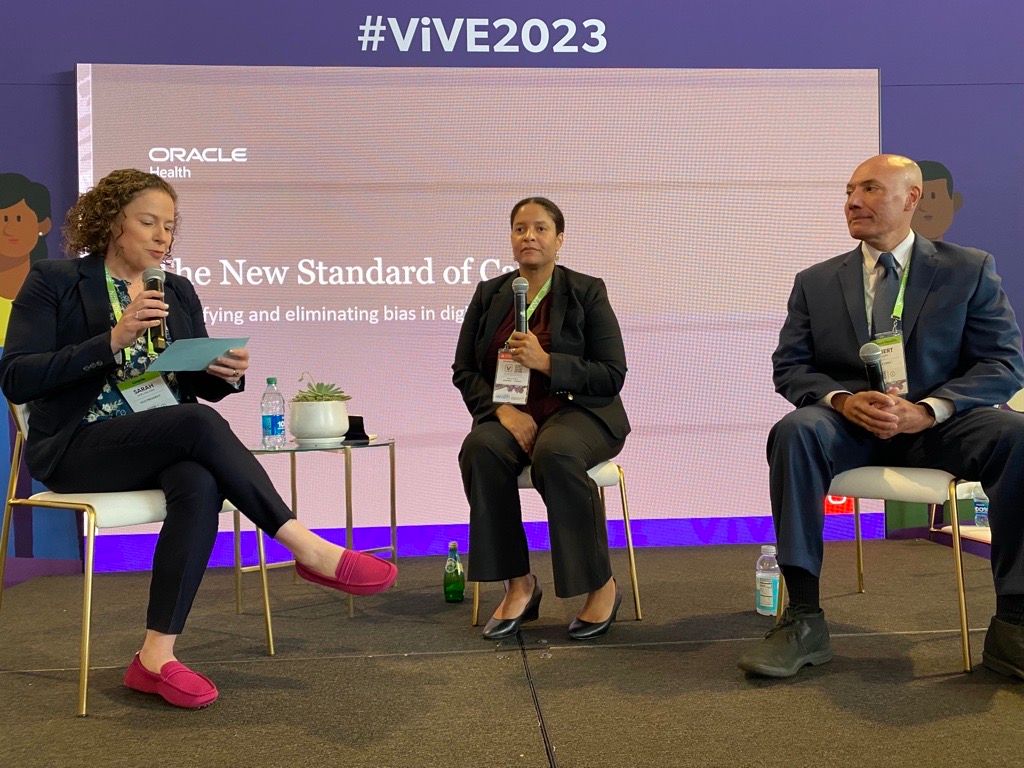Hopes for AI to improve care, avoid lingering bias
Leaders from Nuvance Health talk about the ways technology can close disparities, provided racism doesn’t pervade new tools in healthcare.
Artificial intelligence can help transform medicine, but healthcare leaders must ensure that AI doesn’t reflect decades of structural racism in medicine.
Sarah Matt, vice president of Oracle Health, left, talks with Brenda Ayers, medical director for health equity at Nuvance Health, and Albert Villarin, chief medical informatics officer at Nuvance Health, during the ViVE Conference in Nashville.

As chief medical informatics officer of Nuvance Health, Albert Villarin clearly understands the power of data to improve health.
“AI will revolutionize how we practice medicine,” Villarin said in a discussion on technology and health equity at the ViVE Conference last week.
Villarin said AI offers the potential to improve health equity. But he said healthcare providers and researchers need better data, explaining that doctors have been trained on “bad data” for 60 years.
In much of medicine today, Vallarin said, “We’re not practicing evidenced-based medicine.”
Brenda Ayers, medical director of health equity at Nuvance Health, said like other industries, “healthcare is fraught with bias. There’s no way around it.” Accepting that all clinicians have biases is a first step, she said.
Clinical support tools often lead to biased outcomes because of the bad data or bias that go into them.
“A lot of times clinicians don’t even know they’re being supported by these tools,” Ayers said.
While medicine is viewed by the public as scientific, it’s infused with structural racism, she said.
After a great deal of work, healthcare leaders are starting to see some gains in efforts to eliminate bias in clinical support tools and algorithms.
In one well-publicized example, the Organ Procurement and Transplantation Network has prohibited use of a flawed test of kidney function in determining eligibility for transplants. Critics have said the tests improperly measure kidney function in Black patients, and they’ve been delayed in getting proper treatment, including placement on transplant waiting lists.
The transplant board recently adopted changes allowing some Black patients who have been unfairly delayed to potentially get transplants sooner.
Researchers have also pointed out bias in a risk calculator used to evaluate if women can safely have a vaginal birth after a C-section. Black and Hispanic patients have been less likely to be steered toward vaginal deliveries based on the flawed calculator, researchers say.
Still, Villarin said he’s optimistic about the prospects of AI, with proper guidance, developing a new standard of care, enabling all patients to be cared for equally. When patient records have more data, AI can pull more information on best practices.
“It’ll be based on individuality and people and who they are,” Villarin said.
Health systems need to collect more data from patients, and that means building trust with patients and assuring them their private health information will be collected and help provide better, more personalized care. “That will take some time,” Villarin said.
Healthcare organizations aiming to make changes should “start inside and work your way out,” Ayers said. Leaders should examine the governance and infrastructure of their organizations.
Healthcare leaders looking to improve health equity in their organizations must make those efforts goals for the entire system.
“This has to come from the CEO, the chief medical officer, the chief operating officer, so it’s integrated in everything we do and is not the flavor of the month,” Ayers said.
Villarin also called for medical schools to train physicians not just on the medical aspects of healthcare but “the social aspects of healthcare.”
“We can start with technology, but the social aspects of healthcare have to evolve to achieve the goals we want,” he said.
Physicians can make a difference in improving care in their one-on-one encounters with patients.
“The interaction between clinician and patient is the first step in building the future,” Villarin said.
Telehealth faces a looming deadline in Washington | Healthy Bottom Line podcast
February 12th 2025Once again, the clock is ticking on waivers for telemedicine and hospital-at-home programs. Kyle Zebley of the American Telemedicine Association talks about the push on Congress and the White House.